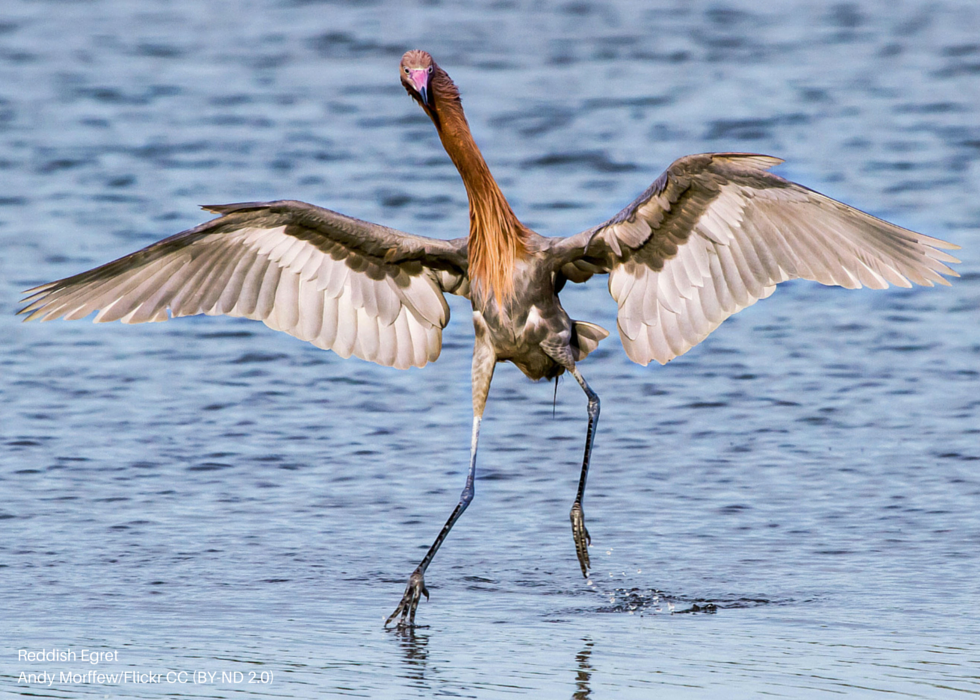
HOUSTON (February 12, 2019) – The challenges are huge, but we have an enormous opportunity to save much of the Gulf Coast for both birds and people. We can’t afford to blow this." said David Yarnold, President and CEO of National Audubon Society (@david_yarnold) after the release of an extensive report, Audubon’s Vision: Restoring the Gulf of Mexico for Birds and People. The report highlights projects and programs critical to help the region and its wildlife recover from devastating hurricanes, oil spills and other environmental and man-made disasters. At the center of the largest ecosystem restoration effort ever attempted, Audubon recommends an investment of more than $1.7 billion in restoration and conservation efforts.
Audubon Texas, the state office of the National Audubon Society, identified critical priorities in the Lone Star State to confront challenges facing birds and their habitats. The Texas coast is home to the world’s largest Roseate Spoonbill and Reddish Egret colonies. Audubon Texas is proposing four projects to manage, restore and even completely build the nearly two hundred coastal islands in the Gulf.
According to Suzanne Langley, executive director of Audubon Texas, “Audubon has been protecting the birds of the Texas coast for almost one hundred years, and we want to make certain the birds and the places they need are still around in another hundred. This is a great opportunity not only for the birds but the coastal communities that depend on healthy and productive ecosystems.”
The BP Deepwater Horizon oil spill of 2010, which resulted in a global settlement of $20.8 billion in claims and cleanup efforts, has left a devastating mark on the Gulf Coast. Audubon recommends 30 state-based, 10 region-wide and four open ocean projects, which together total more than 136,000 acres of restored or protected habitat for bird and human communities from south Texas to the Florida Keys. Audubon Texas and partners in the state and along the Gulf Coast hope to restore, conserve and create nesting and foraging habitat which continues to serve as important refugia away from areas heavily impacted by oil.
“Never before has this amount of funding been dedicated to ecosystem restoration, therefore, we have an unprecedented opportunity to help the Gulf recover,” said Director of Gulf Coast Restoration at National Audubon Society, Kara Lankford. “Wildlife and people living along the coast are dependent on millions of acres of habitat that is at extreme risk unless we act boldly.”
Audubon’s Vision: Restoring the Gulf of Mexico for Birds and People identifies 8.1 million acres of highly suitable habitat across the Gulf for Audubon’s flagship species. The report highlights 29 projects that will collectively address the recovery and population health of these birds as Audubon continues to determine how sea level rise will affect the Gulf and identify ways to better support these species.
With deep roots and a sustained presence on the Gulf, Audubon is committed to working to secure a brighter future for the bird and human communities of this vital region. Implementing priority projects and programs focusing on restoration, conservation, research and stewardship, the National Audubon Society addresses the recovery and population health of the 11 flagship species. For a full project list and details or to learn more and get involved, visit www.Audubon.org/gulf.
About Audubon: The National Audubon Society protects birds and the places they need, today and tomorrow, throughout the Americas using science, advocacy, education and on-the-ground conservation. Audubon's state programs, nature centers, chapters and partners have an unparalleled wingspan that reaches millions of people each year to inform, inspire and unite diverse communities in conservation action. Since 1905, Audubon's vision has been a world in which people and wildlife thrive. Audubon is a nonprofit conservation organization. Learn more how to help at www.audubon.org and follow us on Twitter and Instagram at @audubonsociety.



